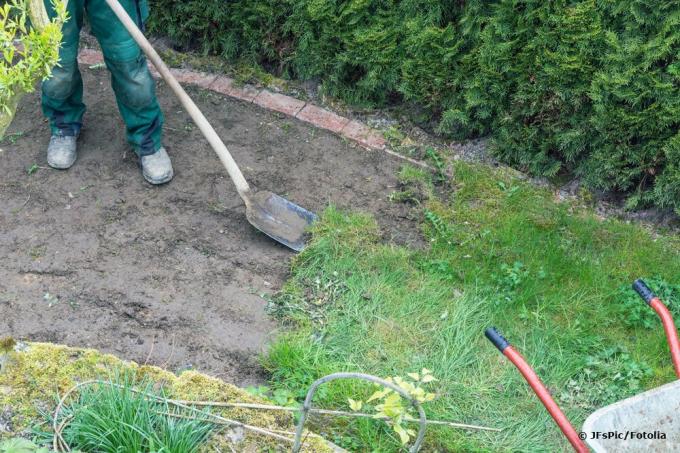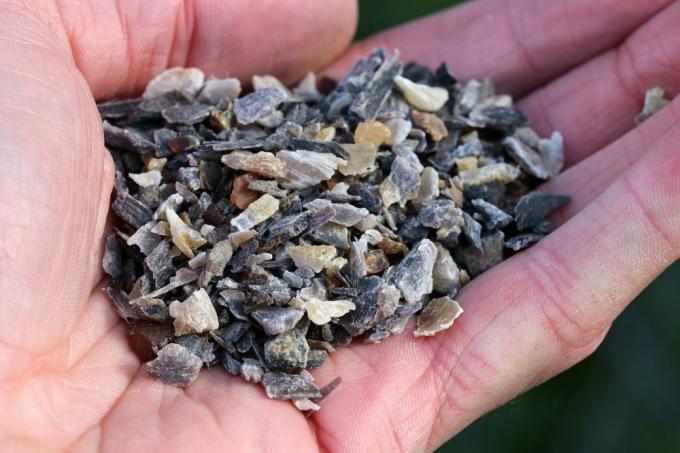
table of contents
- Remove the lawn
- Dig up
- Clean the surface
- fertilization
- Rake
- Water
- Application
- frequently asked Questions
Preparing for new turf is easy, but requires some patience and the right approach. We show you step by step how you can achieve the best possible result.
In a nutshell
- old lawn must be carefully removed
- It is best to start the preparations in the previous year
- Fertilizing is necessary
- Green manuring can be useful
- digging is required in any case
Remove the lawn
The first step in preparing for your new turf is removing the old grass plants. A lawn peeling machine is ideal for this. The procedure is as follows:
- the lawn is mowed as short as possible
- the lawn is cut into strips with the lawn peeling machine
- each lane is individually rolled up and disposed of
Hints: A corresponding machine can be rented from a hardware store, for example. Alternatively, the old lawn can also be cut off with a spade. However, this takes more time and means more effort.

Dig up
So that the roots of the grass plants can grow optimally, the soil must be loose and well ventilated. For this, the earth should be dug up to a depth of at least 30 centimeters.
Tip: During this measure, it is advisable to use lawn edging stones or an irrigation system. Since the earth is already loose and excavated, corresponding changes can be made very easily.
Clean the surface
The removal of the old lawn is not enough. If you want the best results, you need to clear the earth of other debris as well. These include:
- moss
- Stones
- weed
- root
The easiest way to remove this is to use a sieve. You can choose to buy one or build it yourself. Four strips and a piece of close-meshed wire are sufficient for this.
Another advantage of this measure is that the soil can be sifted very finely. Larger clumps, stones, twigs and even any plant bulbs that may be present can be removed very easily. The substrate becomes loose, well permeable and absorbent. This allows the roots of the turf to grow particularly easily.
Tip: Sieve the earth several times. Even if it means more effort, it is worth the effort. If the substrate is very loamy, you can also mix in sand to loosen it up.
fertilization
There are several options for fertilization. These include:
- Ready-made fertilizer
- Horn meal
- compost
A combination of sifted compost and horn meal is ideal and also environmentally friendly. The best variant of the distribution is a spreader and the subsequent incorporation into the earth.
Tip: S.You can also rent a spreader. In the long term, however, it is cheaper to buy, as the necessary nutrients can be distributed more evenly and precisely in doses.

Alternative: green manure
If you already started preparing the substrate for the turf in the spring or summer of the previous year so-called green manure can be a valid alternative to applying additional nutrients represent. This involves sowing plants such as:
- Broad beans
- lupine
- Persian clover
You can also apply a mixture of these. The plants ensure good ventilation of the soil, help in the settlement of soil dwellers and microorganisms as well as the provision of nutrients. In autumn you can mow the plants and work the green cuttings directly into the substrate. Over the winter, the components rot and enrich the soil with nutrients. The disadvantage of this is that the lawn cannot be used for a long time and at first it looks overgrown. The advantage, however, is that the preparation is particularly thorough and creates optimal conditions for a long time.
Rake
So that a level, smooth lawn can be created, you must smooth the area in advance. A simple calculation is sufficient for this. A positive side effect of this measure is that the surface is loosened up again.
Water
Before new turf installed watering must be repeated several times. This is important so that the nutrients can be evenly distributed and penetrate deeper into the soil. Another watering should also be carried out before the individual strips are applied.
Application
A clear advantage of the rolled turf is that you don't have to wait for the seeds to germinate. It grows quickly and therefore plants the area in a short time. Lay out lane by lane and make sure that there are no grooves between the rolls. Then you should water again so that the growth takes place faster. In addition, you should not enter and use the green area at the beginning. The plants need at least one to two weeks to be resilient.

frequently asked Questions
The previous year is ideal. In this way, the soil is optimally prepared and new turf not only grows quickly, but can also be used without any problems shortly after it has been applied.
It can be rolled out from spring to autumn. The only thing to avoid is frost. Spring after the last frost is best. In this way, the lawn can grow and harden well.
Of course, new turf is not the only way to green an area. Sowing grass or meadows of wild herbs is also useful. It takes longer until these areas are accessible and the effort can be higher. The application is, however, cheaper.
